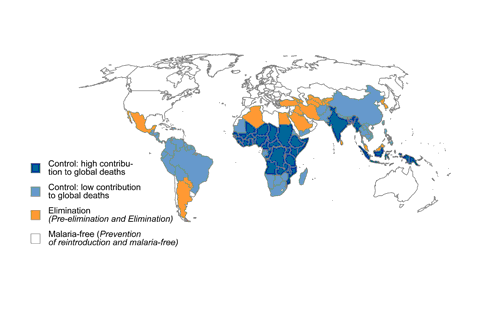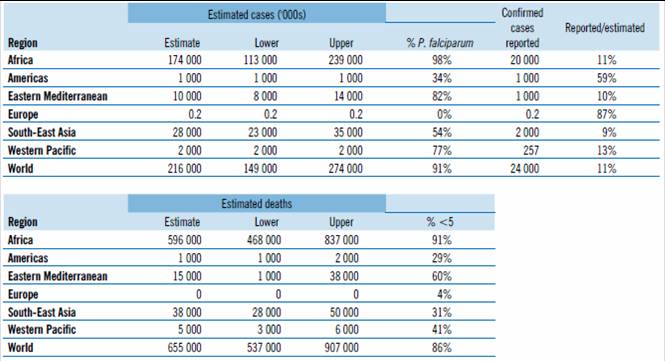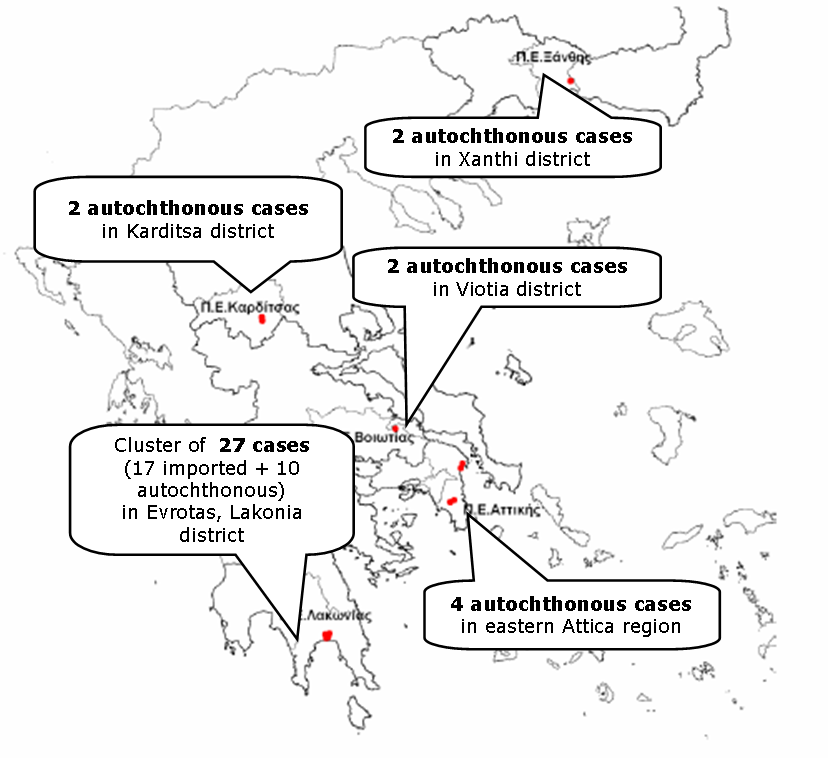|
|
Malaria worldwide:
- Over 100 countries around the world are malaria endemic, mainly in sub-Saharan Africa and Southeast Asia.
- 3,3 billion people (almost half the earth population) was at risk for malaria during 2010.
- 216 million malaria cases were reported in 2010.
- it is estimated that almost 655.000 people died from malaria in 2010.
- Mortality rates have decreased over 25% since 2000 with the largest decline being recorded in Europe.
- During the last six years, countries that have earned the "malaria-free" certification from WHO are: United Arab Emirates (2007), Morocco and Turkmenistan (2010), Armenia in 2011 and Kazakstan (2012).
Figure 1 shows the malaria endemic countries around the world according to their malaria profil (control phase, elimination phase, malaria-free countries), while Table 1 shows the estimated numbers of malaria cases and deaths during 2010.
 Figure 1. Malaria endemic countries around the world (Source: WHO)
Figure 1. Malaria endemic countries around the world (Source: WHO)
Table 1. Estimated malaria cases and deaths during 2010
(Source: WHO World Malaria Report 2011)

Malaria in Europe:
During the period 1957-1963, most european countries managed to eliminate malariaand finally, in 1975, Europe became the first malria-free continent.
Despite intense elimination strategies that were implemented, the situation in Europe changed during 90s, when malaria incidence started to rise again due to:
- political and socio-economical destabilization that led to interruption of control and prevention interventions
- mass migration that led to the re-appearance of the parasite and the emrgence of malaria in Europe
Malaria cases definitions
According to "Disease surveillance for malaria elimination - an operational manual" (WHO, 2012):
Imported: A case the origin of which can de traced to a known malarious area outside the country in which the case was diagnosed
Autochthonous (local): A case acquired by local transmission
Indigenous: any case contracted locally without strong evidence of a direct link to an imported case
Introduced: a case contracted locally with strong epidemiological evidence linking directly to a known imported case
Induced: A case the origin of which can be traced to a blood transfusion or other form of parenteral inovulation but not to normal transmission by mosquito
Situation in Europe
The largest proportion of imported malaria cases is reported by four countries:
- United Kingdom
- France
- Italy
- Germany
The regions with the largest problem of autochthonous malaria is that of Eastern Europe and Central Asia.
During 90s, large scale epidemics took place in countries of Cental Asia and Caucasus.
The countries that are affected the most include Armenia, Azerbaijan, Georgia, Kazakstan, Kyrgystan, Russian Federation, Tajikistan, Turkey, Turkmenistan and Uzbekistan.
Malaria in Greece:
Greece was considered malaria endemic until 1960. After a long and arduous elimination programme that was implemented during 1946-1960, Greece managed to get the "malaria-free" certification from WHO in 1974.
During 1980-2010, an average of 37 malaria cases were reported every year, mostly imported from endemic countries.
Locally transmitted cases were sporadically reported in 1999 (1 case), 2000 (2 cases), 2009 (7 cases) and 2010 (4 cases).
In 2011, 96 malaria cases were reported in Greece. Forty two (42) of them were categorized as autochthonous; 36 of them were detected in Evrotas municipality (South mainland of the country), where 23 imported cases were also reported (21 immigrants from Pakistan and 2 immigrants from Afghanistan). The rest six autochthonous cases were sporadical around the country as depicted in Figure 2.
As for the outbreak in Evrotas (Lakonia district), 28 cases were Greek residents od Evrotas region, while the rest eight (8) were immigrant workers from non-endemic countries. Thirty four (34) of the locally transmitted cases were diagnosed in 2011 while two (2) were manifested and diagnosed during 2012.
Figure 2. Cluster of cases in Lakonia district and autochthonous cases throughouth the country, 2011
In 2012, a total number of 93 malaria cases were reported; 73 of them were categorized as imported while 20 cases were considered autochthonous (Figure 3). In Evrotas area, a cluster of 27 cases was recorded; 10 of them were autochthonous while the rest 17 were imported (13 immigrant workers from Pakistan and 2 from Afghanistan).

Figure 3. Cluster of cases in Lakonia district and autochthonous cases throughouth the country, 2012
Even though Greece was declared "malaria-free" in 1974 by WHO, the risk of re-introduction of the disease always exist do to the following facts:
- the country is full with immigrant workers from malaria endemic countries
- in many regions there are Anopheles mosquitoes
- during last years, the climatic changes favor the reproduction and activation of Anopheles mosquitoes.
Since 2/10/2011 active case detection interventions take place in Evrotas municipality (fever screening, laboratory examination, RDTs, personal interviews) in immigrant populations.
There has been categorization of the country (by the Hellenic Center for Disease Control and Prevention in collaboration with MalWest project) according the estimated risk for locally transmitted malaria and re-establishment of the disease; thus, there are four risk risk levels: 0, 1, 2 and 3 (Table 2).
| Risk level |
Characteristics – risk factors existence |
Regions |
| 0 |
Regions without local transmission risk factors for the last three years, including areas where only an increased presence of malaria parasites in humans (importation of the parasites from malaria endemic countries, e.g. through infected immigrants or travellers) or the presence of mosquito-vectors is observed (or environmental factors favoring their proliferation). |
|
| 1 |
Regions with local transmission risk factors: areas where increased presence of parasites in humans is observed (importation of the parasites from malaria endemic countries) and anopheles mosquitoes are present (or environmental factors favoring their proliferation). |
Ilia district, Achaia district, Aitoloakarnania district, Messinia district, Argolida district, Korinthia district, Evros district
|
| 2 |
Regions where at least one sporadic case was recorded with local transmission indications during last three years. |
Orchomenos municipality (Viotia district), Thebes municipality (Viotia district), Chalkida municipality (Evia district), Marathon and Markopoulo municipality (East Attica district), Agia municipality (Larissa district), Avdiros municipality (Xanthi district)
|
| 3 |
Regions with cluster of cases with local transmission indications during last three years or continuing transmission indications from year to year (new cases in the area during at least two years in a raw). In these areas, it is considered that transmission conditions exist and re-establishment of the disease is possible. |
Evrotas municipality (Lakonia district)
Sophades municipality (Karditsa district) |
Epidemiological situation in Greece - 2013:
Until 16/11/2013, 20 confirmed cases have been reported in Greece. Seventeen (17) of them were imported (10 immigrants form malaria endemic countries and seven travellers to endemic countries), while three cases were considered locally acquired (autochthonous).
For more information, you can visit the following link:
Epidemiological Surveillance Report_Malaria in Greece_16_11_13
|
|
|
|
|